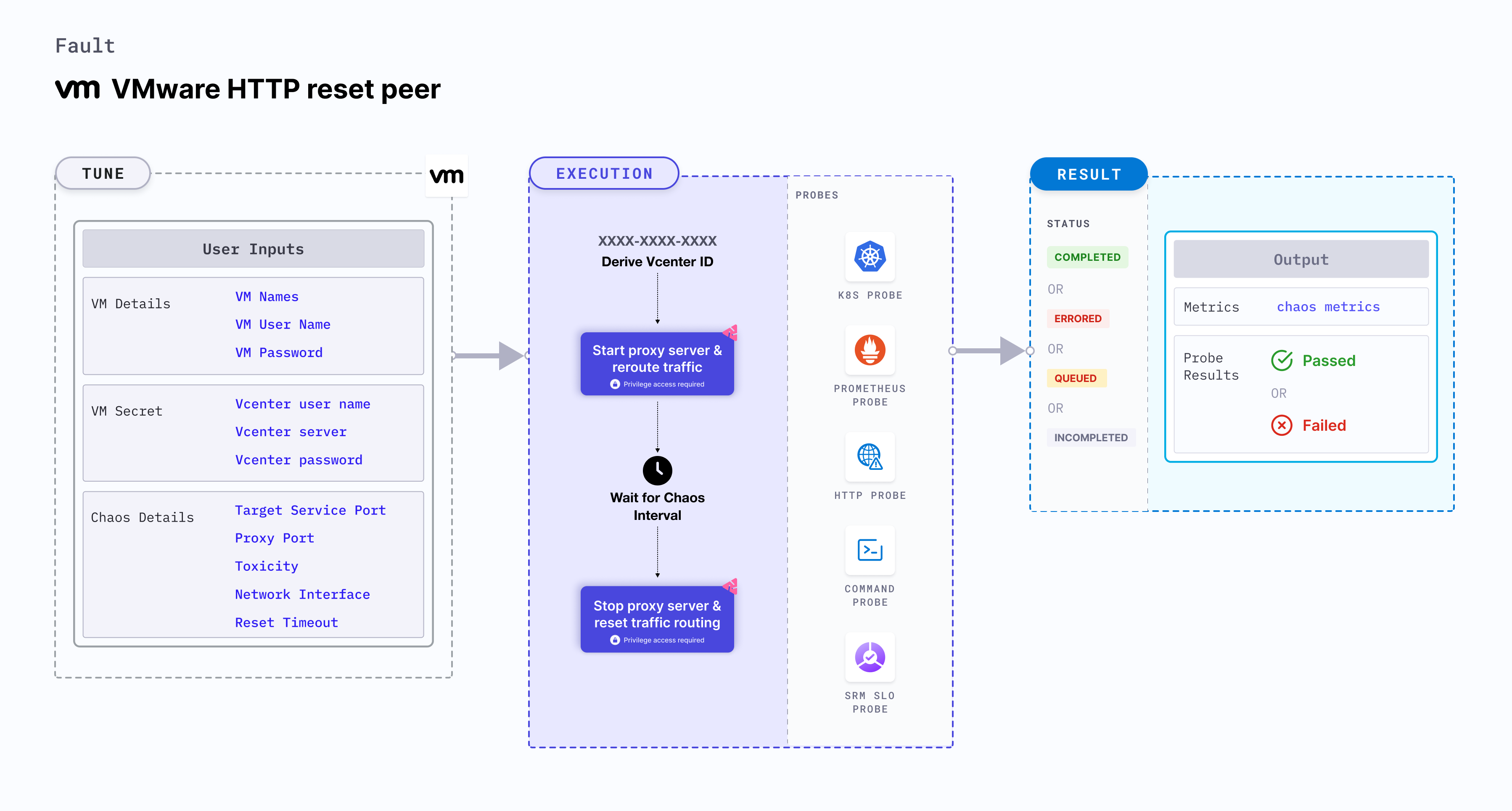VMware HTTP reset peer
VMware HTTP reset peer injects HTTP reset chaos that stops the outgoing HTTP requests by resetting the TCP connection for the requests.
- The service whose port is affected is specified using the
TARGET_SERVICE_PORTenvironment variable. - It tests the application's resilience to lossy (or flaky) HTTP connections.

Use cases
- VMware HTTP reset peer determines the resilience of an application to unexpected halts in the outgoing HTTP requests.
- It determines how quickly and efficiently an application recovers from these unexpected halts.
- It simulates premature connection loss, such as firewall issues, between microservices by verifying connection timeouts.
- It simulates connection resets due to resource limitations on the server side, such as running out of memory, killing processes, or overloading the server due to high amounts of traffic.
Prerequisites
- Kubernetes >= 1.17 is required to execute this fault.
- Appropriate vCenter permissions should be provided to start and stop the VMs.
- The VM should be in a healthy state before and after injecting chaos.
- Kubernetes secret has to be created that has the Vcenter credentials in the
CHAOS_NAMESPACE. VM credentials can be passed as secrets or as aChaosEngineenvironment variable. Below is a sample secret file:
apiVersion: v1
kind: Secret
metadata:
name: vcenter-secret
namespace: litmus
type: Opaque
stringData:
VCENTERSERVER: XXXXXXXXXXX
VCENTERUSER: XXXXXXXXXXXXX
VCENTERPASS: XXXXXXXXXXXXX
Mandatory tunables
| Tunable | Description | Notes |
|---|---|---|
| VM_NAME | Name of the VMware VM. | For example, test-vm. |
| VM_USER_NAME | Username with sudo privileges. | For example, vm-user. |
| VM_PASSWORD | User password. | For example, 1234. |
| RESET_TIMEOUT | It specifies the duration after which the connect is reset. | Defaults to 0. For more information, go to reset timeout. |
| TARGET_SERVICE_PORT | Service port to target | Defaults to port 80. For more information, go to target service port. |
Optional tunables
| Tunable | Description | Notes |
|---|---|---|
| TOTAL_CHAOS_DURATION | Duration that you specify, through which chaos is injected into the target resource (in seconds). | Defaults to 30s. For more information, go to duration of the chaos. |
| CHAOS_INTERVAL | Time interval between two successive instance terminations (in seconds). | Defaults to 30s. For more information, go to chaos interval. |
| SEQUENCE | Sequence of chaos execution for multiple instances. | Defaults to parallel. Supports serial sequence as well. For more information, go to sequence of chaos execution. |
| RAMP_TIME | Period to wait before and after injecting chaos (in seconds). | For example, 30s. For more information, go to ramp time. |
| INSTALL_DEPENDENCY | Specify whether you wish to install the dependency to run the experiment. | Defaults to true. If the dependency already exists, you can turn it off. |
| PROXY_PORT | Port where the proxy listens for requests. | Defaults to 20000. For more information, go to proxy port. |
| TOXICITY | Percentage of HTTP requests that are affected. | Defaults to 100. For more information, go to toxicity. |
| NETWORK_INTERFACE | Network interface used for the proxy. | Defaults to eth0. For more information, go to network interface. |
| DEFAULT_HEALTH_CHECK | Determines if you wish to run the default health check which is present inside the fault. | Default: 'true'. For more information, go to default health check. |
Target service port
It specifies the port of the target service. Tune it by using the TARGET_SERVICE_PORT environment variable.
Use the following example to tune it:
## provide the port of the targeted service
apiVersion: litmuschaos.io/v1alpha1
kind: ChaosEngine
metadata:
name: engine-nginx
spec:
engineState: "active"
chaosServiceAccount: litmus-admin
experiments:
- name: VMware-http-reset-peer
spec:
components:
env:
# provide the port of the targeted service
- name: TARGET_SERVICE_PORT
value: "80"
Proxy port
It specifies the port where proxy server listens for requests. Tune it by using the PROXY_PORT environment variable.
Use the following example to tune it:
# provide the port for proxy server
apiVersion: litmuschaos.io/v1alpha1
kind: ChaosEngine
metadata:
name: engine-nginx
spec:
engineState: "active"
chaosServiceAccount: litmus-admin
experiments:
- name: VMware-http-reset-peer
spec:
components:
env:
# provide the port for proxy server
- name: PROXY_PORT
value: '8080'
# provide the port of the targeted service
- name: TARGET_SERVICE_PORT
value: "80"
Reset timeout
It specifies the reset timeout value that is added to the HTTP request. Tune it by using the RESET_TIMEOUT environment variable.
Use the following example to tune it:
## provide the reset timeout value
apiVersion: litmuschaos.io/v1alpha1
kind: ChaosEngine
metadata:
name: engine-nginx
spec:
engineState: "active"
chaosServiceAccount: litmus-admin
experiments:
- name: VMware-http-reset-peer
spec:
components:
env:
# reset timeout specifies after how much duration to reset the connection
- name: RESET_TIMEOUT #in ms
value: '2000'
# provide the port of the targeted service
- name: TARGET_SERVICE_PORT
value: "80"
Toxicity
It specifies the toxicity value, that is, the percentage of the total number of HTTP requests that are affected. Tune it by using the TOXICITY environment variable.
Use the following example to tune it:
## provide the toxicity
apiVersion: litmuschaos.io/v1alpha1
kind: ChaosEngine
metadata:
name: engine-nginx
spec:
engineState: "active"
chaosServiceAccount: litmus-admin
experiments:
- name: VMware-http-reset-peer
spec:
components:
env:
# toxicity is the probability of the request to be affected
# provide the percentage value in the range of 0-100
# 0 means no request will be affected and 100 means all request will be affected
- name: TOXICITY
value: "100"
# provide the port of the targeted service
- name: TARGET_SERVICE_PORT
value: "80"
Network interface
It specifies the network interface that is used for the proxy. Tune it by using the NETWORK_INTERFACE environment variable.
Use the following example to tune it:
## provide the network interface for proxy
apiVersion: litmuschaos.io/v1alpha1
kind: ChaosEngine
metadata:
name: engine-nginx
spec:
engineState: "active"
chaosServiceAccount: litmus-admin
experiments:
- name: VMware-http-reset-peer
spec:
components:
env:
# provide the network interface for proxy
- name: NETWORK_INTERFACE
value: "eth0"
# provide the port of the targeted service
- name: TARGET_SERVICE_PORT
value: '80'